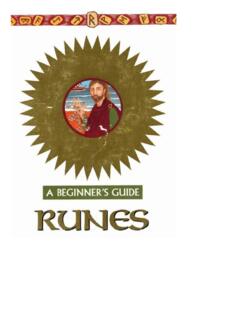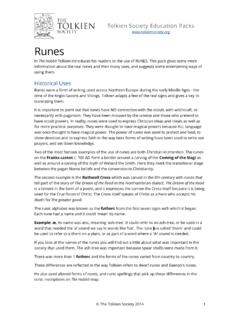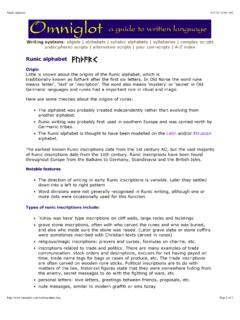Transcription of OLD ENGLISH (OE) ALPHABET AND PRONUNCIATION
1 OLD ENGLISH (OE) ALPHABET AND PRONUNCIATION Old ENGLISH (OE) scribes used two kinds of letters: the runes and the letters of the Latin ALPHABET . The bulk of the OE material OE manuscripts is written in the Latin script. The use of Latin letters in ENGLISH differed in some points from their use in Latin, for the scribes made certain modifications and additions in order to indicate OE sounds which did not exist in Latin. Depending of the size and shape of the letters modern philologists distinguish between several scripts which superseded one another during the Middle Ages. Throughout the Roman period and in the Early Middle Ages capitals (scriptura catipalis) and uncial (scriptura uncialis) letters were used; in the 5th 7th c. the uncial became smaller and the cursive script began to replace it in everyday life, while in book-making a still smaller script, minuscule (scriptura minusculis), was employed.
2 The variety used in Britain is known as the Irish, or insular minuscule. Insular minuscule script differed from the continental minuscule in the shape of some letters, namely d, f, g. From these letters only one is used in modern publications of OE texts as a distinctive feature of the OE ALPHABET the letter Z (corresponding to the continental g). In the OE variety of the Latin ALPHABET i and j were not distinguished; nor were u and v; the letters k, q, x and w were not used until many years later. A new letter was devised by putting a stroke through d or , to indicate the voiceless and the voiced interdental [ ] and [ ]. The letter a was used either alone or as part of a ligature made up of a and e ; likewise in the earlier OE texts we find the ligature (o plus e), which was later replaced by e. The most interesting peculiarity of OE writing was the use of some runic characters, in the first place, the rune called thorn which was employed alongside to indicate [ ] and [ ] it is usually preserved in modern publications as a distinctive feature of the OE script.
3 In the manuscripts one more rune was regularly used, the rune wynn for the sound [wl. In modern publications it is replaced by w. Like any alphabetic writing, OE writing was based on a phonetic principle: every letter indicated a separate sound. This principle, however, was not always observed, even at the earliest stages of phonetic spelling. Some OE letters indicated two or more sounds, even distinct phonemes, Z stood for four different phonemes (see below); some letters, indicating distinct sounds stood for positional variants of phonemes a and . A careful study of the OE sound system has revealed that a set of letters, s, f and (also shown as ) stood for two sounds each: a voiced and voiceless consonant. And yet, on the whole, OE spelling was far more phonetic and consistent than Mod E spelling.]
4 The letters of the OE ALPHABET below are supplied with transcription symbols, if their sound values in OE differ from the sound values normally attached to them in Latin and other languages. Old Englis h A lphabet a n [n], [ ] b 0 c [k] o r [k ] p d r e s [s] or [z] f [f] o r [v ] t Z [g], [g ], [Y] or [j] , [ ] or [ ] [][][9] h u i l m w V x y J [ y ] The letters in OE could indicate short and long sounds. The length of vowels is shown by a macron or by a line above the letter, OE br or; long consonants are indicated by double letters (The differences between long and short sounds are important for the correct understanding of the OE sound system and sound changes, but need not be observed in reading). Rules of Reading in Old ENGLISH In general, the sound meaning of the majority of OE letters, correspond to the sound meanings of corresponding Latin letters.
5 OE etan [etan], OE faran [faran], OE oxa [oksa] etc. However, there are some exceptions and following rules should be observed for letters indicating more than one sound. 1. The letter renders the sound [ ]. In OE manuscripts we often come across the vowel combination ae, instead of . renders the corresponding long vowel. 2. The ligature stands for the sound [ ], like the French sound eu, and German . 3. The sound meaning of the letter y, corresponds to the French u, or German . OE fyllan (to fill), renders a long vowel, OE f r (fire). 4. The letter c stands for two sounds: 1) hard, velar [k]; 2) soft, palatal [k ], which gradually became the affricate [t ]; O E mac ian [ makian] ( to make); OE ceosan [k eozan] (to choose). In a consonant combination sc, c always renders the sound [k]; OE fisc [fisk] (fish).
6 5. The letter n stands for [n] in all positions except when followed by [k] or [g]; in this case it indicates the sound [ ]; OE sinZan [si gan] (to sing). 6. The letter Z represented four different sounds: 1) an initial Z before consonants and back vowels and medial Z after n, represented the voiced stop [g]; OE Z d [g d] (good), OE Z s [g s] (goose), OE sinZan [si gan] (to sing) 2) an initial Z before front vowels represented the voiced palatal spirant [j]; OE Zeard [j ard] (yard), OE ZeonZ [jeo g] (young). 3) After back vowels and after the consonant r, the letter Z represented the voiced guttural spirant [Y] (this sound corresponds to the Georgian sound ); OE beorZ [beorY] (mountain, ); OE daZas [daYas] (days ). 4) The letter Z also represented soft, palatal [g ], which gradually developed into a soft affricate [dZ].
7 Double g was represented by the letters cZ, OE secZan [seggan] (to say). 7. The letters f, s and , stood for voiced fricatives between vowels and also between a vowel and a voiced consonant; otherwise they indicate corresponding voiceless fricatives; OE fyllan [fylan] (to fill), but OE ofer [over] (over); OE r san [r zan] (to rise), but OE r s [r s] (rose); OE t [ t] (that), but OE o er [o er] (other). 8. The vowel combination ea renders a diphthong [ a] in OE; OE bearn [b arn] (a child). 9. The vowel combination eo represents the diphthong [eo] in OE. 10. The vowel combinations io and ie rendered the diphthogs [io, ie]. However, from the X century this diphthongs developed into monophthongs [i, y].


